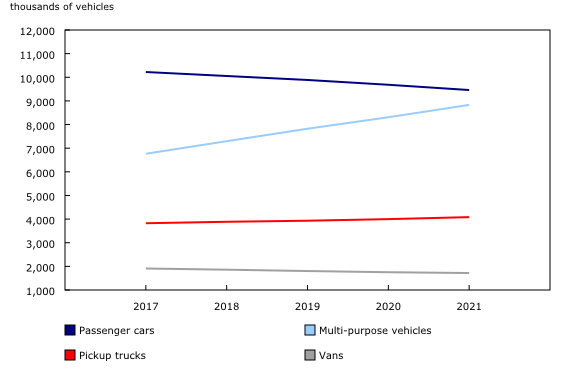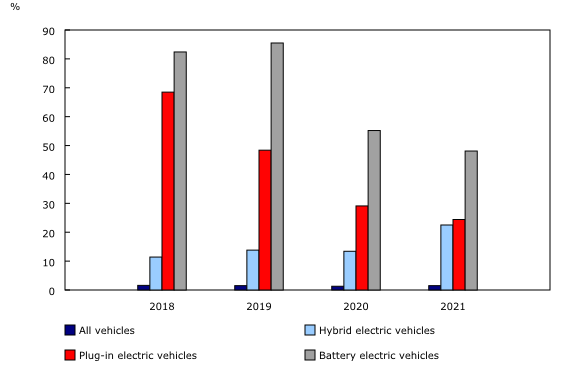Vehicle registrations, 2021
Released: 2022-12-01
26.2 million
2021
1.9% 
(annual change)
Highlights
The total number of road motor vehicles registered in Canada increased to 26.2 million in 2021, up 1.9% compared with 2020.
At 24.1 million, light-duty vehicles accounted for 9 out of every 10 motor vehicles registered in 2021, with passenger cars remaining the most common type. However, registrations of multi-purpose vehicles have experienced the most growth over the last five years.
While there are more electric vehicles being registered across the country, British Columbia and Quebec lead the way.
Please visit the Light and medium-duty vehicle registrations: Interactive Dashboard to interact with the data.
New — Registrations by fuel type
The transportation sector accounts for roughly one-quarter of Canada's greenhouse gas emissions. As such, reducing overall emissions includes changes in this sector. Several provinces have introduced incentive programs and are planning infrastructure to support the transition to alternative-fuel vehicles, mainly electric.
Previously, Statistics Canada provided annual counts of registered vehicles in Canada. However, to track electric vehicle penetration, the agency has now added a crucial piece of information—fuel type—to these vehicle counts. This will help assess the prevalence of zero-emission vehicles (ZEVs) in Canada and is now aligned with the agency's New motor vehicle registrations program.
Slight increase in total registrations
The total number of road motor vehicles registered in Canada grew 1.9% in 2021 to 26.2 million vehicles. Light-duty vehicles (LDVs), which include passenger cars, multi-purpose vehicles, pickup trucks and vans, accounted for 9 out of every 10 motor vehicles registered in 2021. The number of LDVs registered reached 24.1 million vehicles, up 349,738 units (+1.5%) from 2020.
Medium-duty vehicles (MDVs) experienced large increases in registrations in 2021, up 6.7% from 2020. Registrations of heavy-duty vehicles rose 4.3% in 2021, following a relatively flat number of registrations in 2020. Conversely, total registrations for buses were down 3.7% in 2021 compared with 2020, as the COVID-19 pandemic continued to have an impact on public transit for example.
Finally, registered motorcycles experienced the largest growth in 2021 when compared with other classes of vehicles, up 9.0% over the previous year.
Multi-purpose vehicles increasingly popular
A shift in the type of LDVs registered continued over the last five years. In 2017, close to half (45.0%) of LDVs were passenger cars, while under one-third (29.8%) were multi-purpose vehicles (MPVs), which include sports utility vehicles and crossovers.
In 2021, the popularity of MPVs grew to over one-third (36.6%) of LDVs registered, while passenger cars dropped to 39.3%, although they remain the most common type of LDVs, at 9.5 million registered in 2021.
Registrations in light-duty pickup trucks increased to more than 4 million vehicles in 2021, up 2.1% (or about 85,000) from 2020. Conversely, registrations in vans dropped 2.0% in 2021 to 1.7 million registered vehicles.
Electric vehicle registrations surging
Canadians' heightened focus on clean energy is reflected in the type of fuel used by vehicles. While 94.9% of all registered LDVs remained motor gasoline in 2021, there were 303,073 hybrid electric vehicles as well as 152,685 battery electric vehicles (BEVs) and 95,896 plug-in electric vehicles (PHEVs) registered. All three of these categories grew sharply from 2020 to 2021, with notable increases for PHEVs (+24.4%) and BEVs (+48.1%).
According to new motor vehicle registrations, growth in what is commonly referred to as zero-emission (or ZEVs) has continued into 2022, with BEVs and PHEVs comprising 6.9% of all new vehicles registered during the second quarter of 2022.
However, in the same quarter, the registration of new MPVs was three times those of new passenger cars. Since MPVs on average tend to be heavier and less fuel efficient than passenger cars, the net reductions in greenhouse gas emissions from more ZEVs can be offset by more MPVs.
It is common for MDVs to use diesel—more efficient and cost effective than gasoline—as their fuel source. In 2021, about two-thirds of registered MDVs were fuelled by diesel. This class of vehicles has been slower to transition to ZEVs.
Provincial unevenness in zero-emission vehicles adoption
Most provinces and territories saw increases in road motor vehicle registrations in 2021, following decreases during 2020, when the pandemic first hit. Some of the biggest changes were seen in Atlantic Canada. For example, Prince Edward Island had the largest increase in road motor vehicle registrations in 2021, up 9.3% from 2020. Newfoundland and Labrador experienced its first increase in registered road motor vehicles after several years of declines.
Looking at the fuel types for LDVs, British Columbia, followed by Quebec, had proportionately more ZEVs than other jurisdictions. In 2021, ZEVs accounted for roughly 2.0% of all registered LDVs in British Columbia and Quebec. Both provinces have an abundance of hydroelectricity and have provided incentives to encourage ZEV adoption. However, the transition to alternative-fuel vehicles is underway across the country.
Note to readers
This annual release presents a count of registered vehicles based on administrative files provided by each province and territory. Registered vehicles include road motor vehicles, such as light road motor vehicles, medium-duty and heavy-duty vehicles, buses, motorcycles, and mopeds.
Data on vehicle registrations were taken from data table 23-10-0308-01 and are not directly comparable with data table 23-10-0067-01.
Gross Vehicle Weight Rating (GVWR): the maximum weight a vehicle is designed to carry. Manufacturers set the GVWR.
Light-duty vehicles refer to vehicles with a GVWR less than 4535 kilograms and includes GVWR classes 1 and 2.
Medium-duty vehicles refer to vehicles with a GVWR between 4536 kilograms to 11793 kilograms and includes GVWR classes 3, 4, 5 and 6.
Heavy-duty vehicles refer to vehicles with a GVWR greater than 11794 kilograms and includes GVWR classes 7 and 8.
Battery electric vehicles (BEV) are vehicles powered solely by a rechargeable battery pack and produce zero tailpipe emissions.
Plug-in hybrid electric vehicles (PHEV) are vehicles with a rechargeable battery pack and an internal combustion engine. They run on electric power until the battery is drained and then the internal combustion engine takes over for propulsion.
Zero-emission vehicles are BEV or PHEV that have the potential to produce no tailpipe emissions.
Hybrid electric vehicles are vehicles with a rechargeable battery pack, which provides an extra boost of power, in addition to having an internal combustion engine. They are not considered part of zero-emission vehicles.
The Transportation Data and Information Hub—a web portal developed jointly by Statistics Canada and Transport Canada—provides Canadians with online access to comprehensive statistics and measures on the country's transportation sector.
Contact information
For more information, or to enquire about the concepts, methods or data quality of this release, contact us (toll-free 1-800-263-1136; 514-283-8300; infostats@statcan.gc.ca) or Media Relations (statcan.mediahotline-ligneinfomedias.statcan@statcan.gc.ca).
- Date modified:


